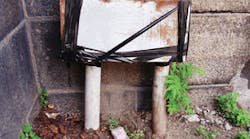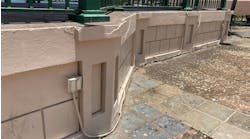How well do you know the Code? Think you can spot violations the original installer either ignored or couldn’t identify? Here’s your chance to moonlight as an electrical inspector and second-guess someone else’s work from the safety of your living room or office. Can you identify the Code violation(s) in this photo?
Hint: Would you consider this an approved use of electrical tape?
Find the Answer
NOVEMBER WINNERS
We had three winners this month: Anuj Vyas, P.E., electrical engineer, Power Distribution Group, Collider-Accelerator Department, Brookhaven National Lab, Upton, N.Y.; Steven G. Rankin, P.E., senior electrical engineer, CB&I, Tyler, Texas; and Chris Apicella, industrial maintenance student, Tennessee Technology Center, Hillsboro, Tenn. They all picked up on the improper bonding jumper connection rather quickly. Here’s what these three had to say:
As you can see in the photograph, the bonding jumper is wrapped around the conduit. According to the requirements of 250.102(E)(2), if installed on the outside of a raceway or enclosure, “the length of the bonding jumper or conductor, or equipment bonding jumper shall not exceed 1.8 m (6 ft) and shall be routed with the raceway or enclosure.” With no measurements in the photo, how do we know the length of the bonding jumper has not exceeded the 6-ft limitation?
It’s also important to note that a bonding jumper should be the same length as the raceway so the impedance increase is insignificant.
I see this type of installation all the time out in the field and am glad someone is addressing it.



